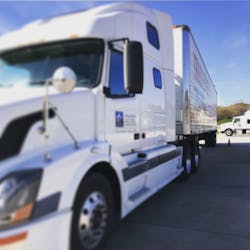“You’re always driving the trailer.”
Sure, this is critical to remember when you’re on the road - especially when making any turns or going through curves with a tractor trailer. But no truer words have ever been spoken when it comes to backing a tractor trailer combination vehicle.
When I first saw our class would be covering nine days on the range just for backing, I raised my eyebrows. But after getting behind the wheel and putting that tractor in reverse? I get it.
Maybe they should have scheduled two full weeks of this. At least.
Backing overview
One portion of the Class A commercial driver's license testing involves mastering three types of backing maneuvers: straightline, offset and 90-degree.
Straightline backing is just that - moving the rig backward in a straight line. I managed the straightline backing pretty quickly. Once I have that tractor trailer in line, it’s some small, easy adjustments to keep the trailer from drifting.
Talk about frustration when it comes to maneuvering that rig in any discernible direction other than straight back, though. Off-tracking is a relatively simple concept to grasp when it comes to driving forward. But, you put that vehicle in reverse, and all hell breaks loose.
The offset backing involves backing at a slight angle. In other words, you pull ahead out of a parking space, and back into the parking stall just next to that space. The offset proved a bit more challenging, but once I understood that slight movements of the steering wheel can control the direction of the vehicle, it was a relatively simple concept.
Think you've mastered backing? Any confidence I had built up understanding the straightline and offset backing maneuvers was initially thrown out the window with the 90-degree backing. This type of backing is the most challenging, and is meant to replicate backing into a dock. A dock that might be in an urban area, with multiple buildings, people and other obstacles in the way.
In general, backing a tractor-trailer is not like backing a regular passenger vehicle. When you’re backing up in a car, you turn the wheel to the left, the tail end of your vehicle turns in the direction of your steer (left). That’s technically still the case when backing a tractor trailer, since your tractor tires will do that when you reverse. But, the pivot point for the trailer on the kingpin means that trailer is going the opposite direction of the way you’re turning the steering wheel (e.g. right). Wrap your head around that, without being able to see anything behind you.
Concepts to consider
While you can’t see anything behind the trailer, you can see the sides. That’s because when you’re backing, you have to use your side mirrors. (Except for sticking your head out the driver's side window in the case of lining up for the 90-degree backing.) There’s no way to look out the side window and know anything about what that trailer is doing.
As soon as you lose sight of the trailer in one mirror, you need to switch your gaze to the other mirror. All while figuring out which direction, and just how much of a touch to turn that steering wheel.
Another important concept is that slight movements of the steering wheel can have a big impact, especially if you're at a farther distance from the parking stall. For instance, with a 90-degree turn, where you're turning the wheel the most for the setup, you're only turning that steering wheel half to three-quarters of a turn at the beginning of the backing. That's it. Any more than that, and you're swinging that tractor all over the place, and constantly losing your target in the mirrors. (I get it, that's easier said than done. Especially when you're first starting out.)
One other thing to remember: think 15 feet ahead (err, behind?). In other words, you need to account for where the trailer will be in 15 feet. That's because any movement you make with the steering wheel will take about that length to react to your movement.
Perfecting the skill
I spent an exorbitant amount of time Googling and watching YouTube videos on how to back a big-rig. While they helped understand the concept, it's no replacement for the practice needed to understand what you're doing when you're in reverse and turning that steering wheel.
There are different ways to explain the same concept: Turn the wheel toward the drift to correct the drift. Or, turn the steering wheel toward the direction you want to "bump" the trailer. The concept that helped me understand the direction of the trailer, especially for the 90-degree backing, was this: imagine the steering wheel represents the tractor and trailer. The top of the steering wheel is the tractor; the bottom is the trailer. If you turn the steering wheel to the right, the top (tractor) goes right, the bottom (trailer) goes left. Or, vise versa, if you turn the steering wheel to the left, the top (tractor) goes left and the bottom (trailer) goes right.
I am now a converted evangelist when it comes to having nearly two full weeks of class time dedicated to backing. Because practice makes (near) perfect. Or, at least it'll help you pass the test. More on that next time.
...
In the Driver’s Seat is a blog series from Fleet Maintenance Editor-in-Chief Erica Schueller. The series covers the process of attending a formalized technical training professional truck driving program in order to obtain a Class A commercial vehicle driver’s license.
About the Author
Erica Schueller
Media Relations Manager | Navistar
Erica Schueller is the Media Relations Manager for Navistar.
Before joining Navistar, Schueller served as Editorial Director of the Endeavor Commercial Vehicle Group. The commercial vehicle group includes the following brands: American Trucker, Bulk Transporter, Fleet Maintenance, FleetOwner, Refrigerated Transporter, and Trailer/Body Builders brands.
An award-winning journalist, Schueller has reported and written about the vehicle maintenance and repair industry her entire career. She has received accolades for her reporting and editing in the commercial and automotive vehicle fields by the Truck Writers of North America (TWNA), the International Automotive Media Competition (IAMC), the Folio: Eddie & Ozzie Awards and the American Society of Business Publication Editors (ASBPE) Azbee Awards.
Schueller has received recognition among her publishing industry peers as a recipient of the 2014 Folio Top Women in Media Rising Stars award, acknowledging her accomplishments of digital content management and assistance with improving the print and digital products in the Vehicle Repair Group. She was also named one Women in Trucking’s 2018 Top Women in Transportation to Watch.
She is an active member of a number of industry groups, including the American Trucking Associations' (ATA) Technology & Maintenance Council (TMC), the Auto Care Association's Young Auto Care Networking Group, GenNext, and Women in Trucking.
In December 2018, Schueller graduated at the top of her class from the Waukesha County Technical College's 10-week professional truck driving program, earning her Class A commercial driver's license (CDL).
She has worked in the vehicle repair and maintenance industry since 2008.

